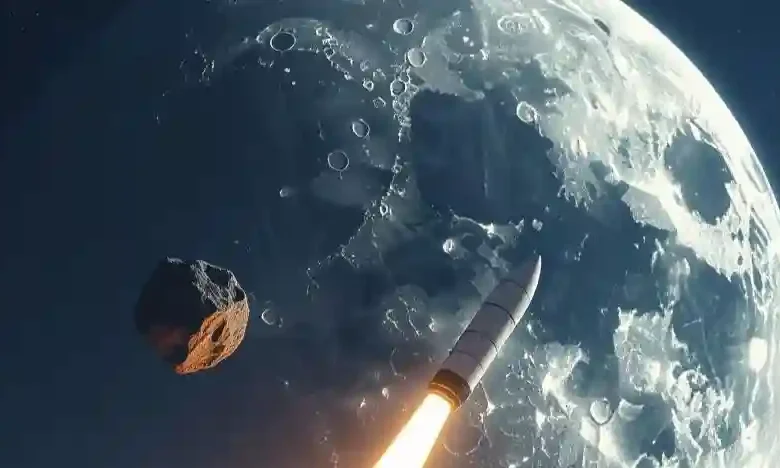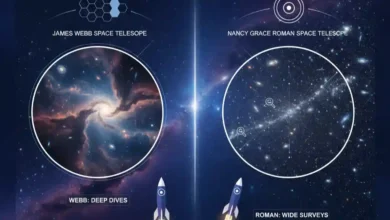NASA May Fire Nukes to Save the Moon in 2032

When we think about space threats, asteroids hitting Earth usually dominate the headlines. But a fresh cosmic challenge has shifted the conversation: an asteroid named 2024 YR4, discovered in late 2024, no longer poses a direct danger to Earth—but it might smash into the Moon in December 2032. With a current estimated 4% probability of lunar impact, this scenario has rattled astronomers, space agencies, and planetary defense experts worldwide.
Now, for the first time in modern history, NASA scientists and researchers are openly considering one of the most controversial planetary defense strategies imaginable: the detonation of nuclear explosive devices in space.
This raises urgent questions: Should humanity use nuclear technology in space to save the Moon? How dangerous is this asteroid really? And what are the broader implications for science, security, and humanity’s cosmic future?
The Asteroid: 2024 YR4
2024 YR4 was flagged shortly after its discovery as a Potentially Hazardous Asteroid (PHA). Initial orbit models indicated a very slim probability—around 3%—of striking Earth in the 2030s. However, refined observations have eliminated Earth as a direct target. Instead, the asteroid’s updated trajectory now shows a possible lunar impact window in December 2032, though the odds remain relatively low at 1 in 25.
Key details about asteroid 2024 YR4:
- Diameter: Estimated 400–600 meters wide
- Composition: Likely a carbonaceous chondrite (rich in carbon, volatile materials, and water-bearing minerals)
- Current orbit: Near-Earth trajectory with periodic approaches every decade
- Potential velocity at impact: ~20 km/s
If such a rock were to smash into the Moon, the consequences might not be apocalyptic for Earth—but they would still be astronomically significant.
What Happens If It Hits the Moon?
Contrary to Hollywood-style fears, an asteroid impact on the Moon wouldn’t shatter it. The Moon is massive and stable. But a strike from 2024 YR4 could have profound consequences:
- Formation of a crater up to 20–30 km wide, with visible scars observable even from Earth.
- Intense seismic activity across the Moon’s surface, potentially destabilizing underground lava tubes—some of which are considered future bases for lunar colonization.
- Ejecta (debris) launched into space, some of which could eventually drift into low Earth orbit, threatening satellites and space infrastructure.
- Optical changes to the Moon’s surface, altering how sunlight reflects from it—an eerie reminder of the fragility of celestial bodies.
- Psychological and cultural impact: The Moon has been a cultural and scientific symbol for millennia. Seeing it visibly scarred by a major asteroid impact could have an emotional, almost civilizational resonance.
For space scientists, the bigger concern is about future lunar missions and colonies, as Artemis and other programs prepare to establish permanent human presence on or around the Moon in the 2030s. A cratered surface and unstable environment could complicate decades of exploration plans.
The Nuclear Option: Last-Resort Defense
NASA and partner agencies, through the Planetary Defense Coordination Office (PDCO), have been refining asteroid deflection models for years. Most strategies involve early action using kinetic impactors (like the successful DART mission in 2022) or gravitational tractors (using spacecraft mass to subtly alter trajectories).
But 2024 YR4 is different:
- Its orbit is still uncertain, leaving only a small reaction window.
- Its target is not Earth, but the Moon, which complicates political and strategic decisions.
- Its size (400–600 m) makes purely kinetic solutions far less effective if deployed late.
This is where the nuclear option enters the discussion. Nuclear explosive devices (NEDs) could be deployed in two ways:
- Surface Detonation – detonate on or just above the asteroid’s surface, vaporizing part of it and creating a powerful recoil force to alter its path.
- Subsurface Detonation – bury explosives within the rock to deliver maximum energy, shattering or redirecting it dramatically.
Both approaches come with massive risks. Instead of deflecting the asteroid, scientists could accidentally fragment it into multiple pieces—some of which might make the situation worse.
Yet, experts increasingly argue that a nuclear intervention could be humanity’s only effective contingency plan if asteroid 2024 YR4 is confirmed to be on a head-on path toward the Moon in 2032.
Ethical and Political Dilemmas
The proposal of detonating nuclear devices in space raises not just technical, but ethical and geopolitical questions:
- The Outer Space Treaty of 1967 explicitly bans placing nuclear weapons in orbit or on celestial bodies. Does an asteroid defense scenario count as a violation?
- Could testing nuclear devices in space reopen Cold War-era security tensions, with rival nations using asteroid defense as justification for militarizing space?
- Who gets to decide? Planetary defense is a global challenge, but NASA currently leads the charge. Would all nations trust NASA—or would they demand international oversight through the UN?
- What if the solution fails, and humanity still watches the Moon get blasted by nature’s fury?
These questions reveal the deep philosophical undertones behind asteroid defense. Humanity’s actions won’t just be scientific—they’ll be moral decisions with global consequences.
Why Save the Moon?
One might ask: why risk nuclear detonation to protect the Moon, when the impact does not directly endanger Earth’s biosphere? The answer is layered:
- Scientific value – The Moon serves as a natural laboratory for geology, astrophysics, and space exploration studies.
- Cultural symbolism – Nearly all human civilizations have revered the Moon as a celestial companion. Its severe damage would mark a historic psychological scar.
- Strategic importance – The Moon is rapidly becoming the cornerstone for future human space expansion. From NASA’s Artemis program to China’s lunar outpost ambitions, colonies, fuel depots, and observatories are expected to emerge in the 2030s. A catastrophic impact could hinder all of that.
- Earth’s safety insurance – While this asteroid threatens the Moon today, its orbit could evolve unpredictably. Protecting the Moon also indirectly protects Earth’s long-term future.
The Countdown to 2032: What Happens Next?
Between now and 2032, astronomers will continue refining the orbit of 2024 YR4 using radar imaging, telescopic tracking, and AI-based simulations. By around 2028–2029, humanity will likely know for certain whether the asteroid’s trajectory intersects the Moon. This leaves only three to four years for a planetary defense mission—an extraordinarily narrow window by astrophysical standards.
Expect to see:
- International discussions through the UN and COPUOS (Committee on the Peaceful Uses of Outer Space).
- Detailed feasibility studies from NASA, ESA, and other space agencies assessing nuclear vs. non-nuclear options.
- Public debate and media frenzy as the asteroid capture headlines closer to 2032, fueling both fear and fascination.
A Glimpse into Humanity’s Future
Asteroid 2024 YR4 is more than a scientific anomaly. It’s a cosmic test of agency. Do we, as a species, have the courage and capability to take decisive action to protect not only Earth, but our celestial partner, the Moon?
If humanity chooses the nuclear path, it won’t just be fighting an asteroid—it will be confronting its own technological, ethical, and cultural thresholds. In many ways, this may be the first true rehearsal of planetary defense that decides the fate of civilizations centuries from today.
The countdown has begun, and the cosmos has once again posed humanity a profound question:
Will we choose to act—or to watch as nature writes history on the face of the Moon?
For more Odinozz Science articles, click here.
Follow Odinozz on social media. Click here.



